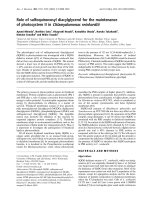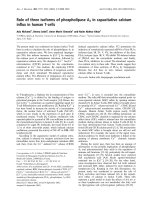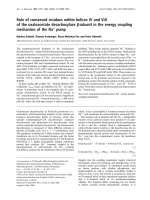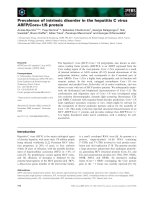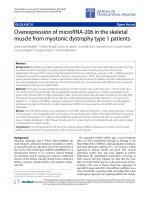Báo cáo y học: "Role of bedside electroencephalography in the adult intensive care unit during therapeutic neuromuscular blockade" doc
Bạn đang xem bản rút gọn của tài liệu. Xem và tải ngay bản đầy đủ của tài liệu tại đây (1.24 MB, 9 trang )
Available online />Page 1 of 9
(page number not for citation purposes)
/>Research
Role of bedside electroencephalography in the adult intensive
care unit during therapeutic neuromuscular blockade
David Crippen
University of Pittsburgh Medical Center, Surgical ICU, St Francis Medical Center, Pittsburgh, PA 15201, USA.
Abstract
Background: Size, weight and technical difficulties limit the use of ponderous strip chart
electroencephalographs (EEGs) for real time evaluation of brain wave function in modern intensive care
units (ICUs). Portable, computer processed, bedside EEGs provide real time brain wave appraisal for
some brain functions during therapeutic neuromuscular blockade when the visual clues of the cerebral
function disappear.
Results: Critically ill ICU patients are frequently placed in suspended animation by neuromuscular
blockade to improve hemodynamics in severe organ system failure. Using the portable bedside EEG
monitor, several cerebral functions were monitored continuously during sedation of selected patients
in our ICU.
Conclusions: The processed EEG is able to continuously monitor the end result of some therapeutics
at the neuronal level when natural artifacts are suppressed or eliminated by neuromuscular blockade.
Computer processed EEG monitoring may be the only objective method of assessing and controlling
sedation during therapeutic musculoskeletal paralysis.
Keywords: brain wave, electroencephalograph, ICU, monitoring, sedation, neuromuscular blockade
Introduction
Aggressive methods of decreasing oxygen consumption,
such as therapeutic musculoskeletal blockade, are used for
patients with marginal oxygen delivery associated with car-
diac and respiratory insufficiency. This is especially true
during exotic mechanical ventilation methods designed to
increase efficiency of oxygen utilization and decrease peak
airway pressures. In addition, hemodynamic deterioration
from the effects of unrestrained musculoskeletal hyperac-
tivity can precipitate angina, heart failure, and cardiac
arrhythmias by increasing myocardial work and oxygen con-
sumption in the face of compromised coronary artery out-
put [1]. Escalating doses of sedatives followed by
oppressive hemodynamic and ventilatory side-effects
sometimes provide an indication for therapeutic muscu-
loskeletal paralysis to rapidly get control of life threatening
agitation syndromes. Brain wave monitoring by portable,
non-invasive computer processed monitors allows quick
recognition of some brain functions under titrated sus-
pended animation in real time, facilitating modulation of
therapy when the visual clues of neuronal function
disappear.
The classic EEG is usually recorded on a ponderous con-
sole with 8 to 32 channels to improve sensitivity. Difficulty
using strip chart EEGs utilizing analog technology stimu-
lated the development of electronically processed digital
EEG monitoring. The processed EEG does not require as
many head electrodes to generate a satisfactory signal that
can be utilized for useful clinical data in the ICU. Current
practice for digitally processed electroencephalography is
to non-invasively place soft, moist contact electrodes
across the forehead after skin preparation with an anti-oil
solution. This procedure is quick and easy for the ICU staff
to perform and requires no sophisticated training.
The interpretation of an EEG tracing involves the quantifi-
cation of signal strength and recognition of patterns [2].
Received: 25 September 1996
Revisions requested: 22 November 1996
Revisions received: 25 November 1996
Accepted: 14 January 1997
Published: 13 August 1997
Crit Care 1997, 1:15
© 1997 Current Science Ltd
(Print ISSN 1364-8535; Online ISSN 1466-609X)
Critical Care Vol 1 No 1 Crippen
Quantification of the amplitude and frequency can be effec-
tively accomplished with any signal monitor EEG. Pattern
recognition, that of signal morphology, spatial and temporal
distribution, and wave form reactivity is more difficult and is
subject to observer interpretation. These parameters are
not evaluated very effectively by raw signal EEG monitors,
but some progress has been made using computerized
processed signal EEGs. The electrical activity from eye
movements, facial muscles, respiration, and the heart's
electrical limits the effectiveness of bedside EEGs for rou-
tine use in the ICU, but under neuromuscular blockade,
these artifacts are minimized and a relatively pure signal is
obtained. Advantages of the processed EEG during neu-
romuscular blockade are that the data are more easily inter-
preted by physicians not specifically trained in
electroencephalography. These trends may then be inter-
preted more quickly in the acute care setting, resulting in a
faster clinical intervention where needed [3].
Practical electroencephalography
The frequency ranges of brain electrical activity are divided
as follows, where the amplitude is measured from peak to
peak:
Delta: < 4 Hz
Theta: 4–8 Hz
Alpha: 8–12 Hz
Beta: ≥ 13 Hz
The continuum from wakefulness to sleep involves a pro-
gressive decrease in the alpha band followed by increased
activity in the beta, theta and delta bands. The alpha rhythm
contains waves of 8-12 Hz and is very responsive to voli-
tional mental activity, increasing with excitement and
decreasing with tranquility. These rhythms occur mainly in
the posterior head and are the predominant brain activity in
the normal brain. The beta rhythm occurs in the prefrontal
regions and has been associated with increased cognitive
activity. Higher levels of beta activity have also been asso-
ciated with anxiety and delirium [4]. During the induction of
general anesthesia, transient beta activity can also indicate
the initial anxiolytic and amnestic stage of sedation. Both
theta and delta waves are seen in stages three and four of
normal sleep, and not in awake adults [5].
Interpretation of signals: commonly used
medications in the ICU
Narcotic analgesics
In lower doses, narcotics in general tend to increase the
amplitude of both alpha and beta frequency bands. Clini-
cally, patients have reported their mood during these
changes as associated with a sense of well being. In higher
doses, theta and delta frequencies develop, heralding the
onset of sedation.
Fentanyl and morphine
The effect on the EEG of intravenous fentanyl in doses of
30–70 µg/kg, following premedication with oral lorazepam
4–5 mg or 10 mg intramuscular morphine, was studied in
cardiac surgery patients [6]. Within 1 min, the normal alpha
rhythm was replaced by diffuse theta waves, followed
quickly by predominant delta activity consistent with
anesthesia. Lower doses of fentanyl resulted in slowed
alpha activity with an increase in theta bands. In the cat,
very high levels of fentanyl, in the range of 40–80 µg/kg
produced seizure-like activity [7]. The EEG response after
administration of morphine is similar to that of fentanyl, and
resembles the pattern demonstrated by the centrally acting
serotonin uptake inhibitors and alpha-2 agonists such as
clonidine [8].
Meperidine
Administration of meperidine in usual analgesic intramuscu-
lar doses, produced a picture of alpha activity voltage
reduction and the appearance of slow waves of intermedi-
ate voltage, consistent with mild hypnosis [9].
Benzodiazepines
In low doses, the anxiolytic action of benzodiazepines tends
to decrease the percentage of alpha activity while increas-
ing the prevalence of beta waves over 18 Hz [8]. At high
doses, theta and delta activity occurs, expressing the sed-
ative activity of the drug.
Figure 1
The ASPECT A1000
®
, a typical brain wave monitor capable of real time
bedside EEG.
Available online />Page 3 of 9
(page number not for citation purposes)
Midazolam
In one study of ICU patients receiving midazolam, alpha fre-
quency decreased and beta activity became prominent. In
higher doses, these changes disappeared to be replaced
by delta/theta activity [10]. The onset of action and recov-
ery following intravenous administration of midazolam is
rapid. When administered to counteract sedative effect, the
benzodiazepine antagonist flumazinil quickly normalizes
alpha wave activity [11].
Lorazepam
EEG effects were relatively slow in onset, reaching base-
line over 30 min after infusion, and with a prolonged dura-
tion of action compared to diazepam. Increased activity in
the 13–30 Hz range was prolonged, followed by increased
sedative activity [12].
Non-benzodiazepine hypnotics
Propofol
Administration of propofol for anesthesia initially produced
an increase in the amplitude of the alpha rhythm, followed
by an increase in delta and theta activity and burst suppres-
sion in some patients, consistent with anesthesia [13].
There is a very rapid onset of action and recovery following
intravenous administration of propofol.
Barbiturates
Intravenous administration of short acting barbiturates ini-
tially increases the amplitude of beta activity. Increasing
doses of barbiturates can produce a pattern of coincider
delta and beta activity [14]. Large doses create a sedative
pattern of delta/theta activity.
Adjuncts to sedation
An alpha-2 adrenoreceptor agonist is capable of potentiat-
ing narcotic actions. EEG effects of clonidine are similar to
narcotics.
Figure 2
(a) Cerebral electrical activity in a healthy volunteer, sitting in a quiet
environment reading a magazine. Activity at normal sensitivity under 13
Hz to the left of the trend line. (b) A patient mildly sedated with
lorazepam. The `monotony of sedation' pattern is illustrated. The spec-
tral edge frequency (95% of brain wave activity occurring to the left of
this line) demonstrates less variation between epochs.
Figure 3
(a) Cerebral function tracing of an ICU patient who is alert, oriented,
and aware but stimulated and anxious due to the frenetic ICU environ-
ment. There is progressively increased activity in the beta (> 13 Hz)
ranges. (b) The same patient sedated with a continuous infusion of 2
mg/h midazolam. Narcotics and benzodiazepines in sedative doses
generally induce a gradual reduction in activity at higher alpha (8-13
Hz) and beta (> 13 Hz) frequencies and increased activity at lower fre-
quencies, especially theta (4-8 Hz) and delta (<4 Hz). The `activity line'
shifts symmetrically to the left.
Critical Care Vol 1 No 1 Crippen
Clonidine
The sedative action of the alpha-2 agonist clonidine is com-
monly appreciated in the ICU setting [15]. The EEG
response to clonidine is similar to that of morphine and
thought to have a similar central mode of action [16]. Clo-
nidine increased the time rats spent in the drowsy stage of
wakefulness, which corresponds to behavioral sedation
and inhibited REM sleep for 6–9 h after administration [17].
Interpretation of signals: altered physiology
Carbon dioxide
Hypocarbia causes slowing of the EEG. Small increases in
pCO
2
(5–20% above normal) cause decreased cerebral
excitability and an increased electroshock seizure thresh-
old. Higher levels (30% above normal) result in increased
cerebral excitability and epileptiform discharges. High lev-
els (50% above normal) produce EEG depression [18].
Oxygen
Hyperoxia causes a low amplitude, fast frequency EEG pat-
tern characteristic of cerebral excitation [19]. Decreased
brain oxygenation initially causes increased cerebral excita-
bility as a result of peripheral chemoreceptor stimulation
and its attendant effects on the brain's reticular activating
system [20]. If hypoxia persists and overwhelms compen-
satory systems, diffuse EEG slowing occurs, eventually
leading to EEG silence as anoxia approaches [21].
Figure 4
Effect of midazolam as an intravenous sedative. This anxious patient
was administered 2 mg intravenous midazolam during continuous EEG
monitoring. The frequency diminished quickly in about 2 min, demon-
strating the rapid clinical action of the short acting sedative. The action
of propofol is similar to midazolam.
Figure 5
The effects of midazolam administration observed in a trend mode.
Midazolam (4 mg) was administered in a bolus to an anxious patient at
the arrow. Low frequency delta activity (thin line) shows a slow progres-
sive increase. High frequency beta activity (thick line) decreases quickly
and remains low.
Figure 6
Effect of lorazepam as an intravenous sedative. This anxious patient
was administered 2 mg intravenous lorazepam during continuous EEG
monitoring. The frequency diminished slowly in about 12 min, demon-
strating the prolonged clinical action of the longer acting sedative.
Available online />Page 5 of 9
(page number not for citation purposes)
Body temperature
Hypothermia causes progressive slowing of brain activity at
core temperatures below 35°C. Complete electrical
silence occurs with profound hypothermia (7–20°c) [22].
Sensory stimulation
In the awake patient, stimulation of the senses usually
results in desynchronization of EEG patterns, increased
amplitude and increased frequency [23]. This increase in
activity is directly correlated with increased brain metabolic
activity. High amplitude delta waves can be associated with
global cerebral dysfunction, indicating brain damage or
potentially reversible metabolic suppression of cerebral
function.
Blood flow to the brain
EEG changes correlate well with blood flow to the cortex.
EEG changes begin to occur when blood flow decreases
below 30% of normal [24]. However, neurologic outcome
has not been demonstrated to be strictly dependent on
EEG changes during periods of low flow, but more on dura-
tion of flow deficits [25].
Role of bedside electroencephalography in the
ICU
The therapeutic use of musculoskeletal paralysis with non-
depolarizing paralytic agents has increased largely
because of the advent of exotic mechanical ventilation
modes that require subjugation of the patient's normal ven-
tilation activity [26]. During such ventilation modes,
Figure 7
Effect of fentanyl as an intravenous analgesic sedative. This anxious
patient with postoperative pain was administered 100 mg intravenous
fentanyl during continuous EEG monitoring. The frequency quickly
diminished in about 3 min, demonstrating the rapid clinical action of the
short-acting analgesic sedative.
Figure 8
Severe CNS depression produces increased amplitude in the delta
band (<4 Hz) and very reduced activity in the other frequencies. (a) This
patient with extremely toxic levels of ethyl alcohol was completely unre-
sponsive on total life support, including mechanical ventilation. (b) The
EEG tracing of a patient with certified brain death, established by EEG
and clinical criteria. The activity line shifts to the right from electrical
activity of the heart picked up by the monitor in the absence of brain
electrical activity.
Critical Care Vol 1 No 1 Crippen
paralysis may benefit ventilation efficacy by decreasing
chest wall muscle tension and peak airway pressure. In
addition, the disparate inhalation and exhalation timing nec-
essary for these modes is difficult for the patient to tolerate,
and paralysis is necessary to avoid the patient fighting
against this unequal inhalation: exhalation (I:E) ratio. Other
uses for therapeutic musculoskeletal paralysis such as
`chemical restraint' to protect health care personnel from
violent behavior [27], and the decreasing of cerebral blood
flow during unstable intracranial pressure following head
injury [28], are relatively rare.
Agitation episodes that threaten hemodynaimc stability are
becoming more common in the ICU as a larger range of
sick patients are identified are cared for. Life threatening
agitation is usually signalled by escalating musculoskeletal
hyperactivity in the face of increasing sedative administra-
tion. Eventually a point is reached where the direct effects
of agitation combined with suppressive side-effects of
pharmacologic agents threaten respiratory and hemody-
namic stability. Agitated delirium syndromes, such as etha-
nol withdrawal, may constitute genuine medical
emergencies as they have potentially disastrous hemody-
namic and metabolic consequences and may become an
indication for therapeutic musculoskeletal paralysis [29].
Severe agitation syndromes such as delirium tremens alter
physiology and can precipitate hemodynamic deterioration
by increasing musculoskeletal activity and metabolic activ-
ity to the point where increasing cardiac output cannot be
sustained by cardiac physiology [30]. This can precipitate
angina, heart failure, and cardiac arrhythmias by increasing
myocardial work and oxygen consumption in the face of a
compromised coronary artery output [27]. In addition, mus-
culoskeletal hyperactivity produces metabolic acidosis that
can precipitate arrhythmias and compromise oxygen
delivery. Hyperactivity in muscle groups not used to
increased work can cause myoglobinuria and renal failure
as well [31].
If agitation resists the titrated effects of rapid-acting, short-
duration sedatives and becomes so severe that hemody-
namic stability is threatened, therapeutic musculoskeletal
paralysis, endotracheal intubation and mechanical ventila-
tion, and titrated hemodynamic support may be necessary
to prevent cardiorespiratory collapse. True `suspended ani-
mation' can be induced to gain complete control of the sit-
uation early, rather than chance the increased hazards of
partial control in unstable circumstances. Unlike benzodi-
azepines that cause musculoskeletal relaxation, non-depo-
larizing, neuromuscular, end plate neurotransmission
antagonists affect therapeutic musculoskeletal paralysis.
Suspended animation using musculoskeletal paralytic
agents will effectively stop the effects of muscular hyperac-
tivity on end organs. It is also extremely important to remem-
ber that underneath therapeutic paralysis lies unprotected
cerebral function. Therefore, the amount of sedation
needed to ameliorate the helpless feeling of paralysis in the
awake state is virtually impossible to determine from any
information gained by a physical examination or an objec-
tive sedation scale such as the Ramsay Score [32].
For the intensivist, advantages of the computer processed
EEG are that the data are more easily interpreted by physi-
cians not specifically trained in electroencephalography
[33]. This technology uses a single bipolar lead to accentu-
ate trends in brain wave activity (mostly frontal cortex),
which may then be interpreted more quickly in the acute
care setting, resulting in a faster clinical intervention where
needed. Sophistication in bedside EEG hardware is
increasing, with multi-channel EEG recording, various data
reduction functions such as the Bispectral Index, and
evoked potential analysis becoming available to the ICU.
Figure 9
EEG assessment of cerebral responsiveness during therapeutic neu-
romuscular blockade, and absence of potential artifacts from face mus-
cle activity and eye blink. (a) Brief increase in higher frequencies
normally associated with increased cognitive activity indicates cerebral
response to a painful somatic stimuli. (b) Cerebral response to endotra-
cheal suctioning in a therapeutically paralyzed patient. Dramatically
increased high frequency waves, possibly indicating discomfort.
Available online />Page 7 of 9
(page number not for citation purposes)
Modern cerebral function monitors survey brain electrical
activity in real time and reflect changes in brain activity
caused by sedatives and other therapeutics [34]. There is
accumulating evidence that regimens utilizing continuous
infusion of sedative agents can be effectively titrated,
assuring patient comfort and neuronal stability under paral-
ysis, while the search for underlying pathology and effective
treatment programs follows [35,36]. Different classifica-
tions and combinations of sedatives, analgesics or antipsy-
chotics can be tried until the combination that brings about
the most appropriately calm cerebral function tracing is
discovered.
Potential practical application of bedside
electroencephalography
Modern miniaturized electroencephalographic monitors
(Fig 1) can be positioned at the bedside, visible to the clin-
ical team but out of the way of nursing procedures. They are
attached to the patient's frontal cranium by non-invasive
patches similar to electrocardiogram (EKG) leads. The
EEG monitor depicts gross brain wave activity in an easily
interpretable fashion, allowing quick recognition of seda-
tion adequacy during therapeutic neuromuscular blockade
when the visual clues disappear. Some objective measure-
ment of cerebral function can be frequently and rapidly
assessed before the patient undergoes therapeutic obtun-
dation, or specifically neuromuscular blockade, then the
effects of sedation can be followed in real time (Figs 2 and
3). The effects of specific sedatives such as midazolam
(Figs 4 and 5), lorazepam (Fig 6), and fentanyl (Fig 7) can
be assessed in real time. The effect of extremely deep
sedation differs from clinical brain death by the presence of
delta waves and the absence of EKG artifacts (Fig 8). A
sedated patient undergoing neuromuscular blockade who
is vigorously stimulated shows a brief `waking' pattern,
demonstrating the sensitivity of monitoring cerebral
responsiveness when the visual clues are not present (Fig
9). Adequacy of sedation can be titrated in real time,
reflecting relatively small changes in therapy, such as inad-
vertent oversedation, on brain function (Fig 10).
Once a patient with compromised respiratory or vital func-
tions is placed on life support hardware, sophisticated
monitoring devices such as continuous pulse oximetry,
continuous mixed venous oximetry, and capnography effec-
tively monitor hemodynamic and ventilatory parameters.
Figure 10
(a) Patient with severe delirium tremens and life threatening agitation demonstrating multiple musculoskeletal artifacts on the EEG. (b) Neuromuscu-
lar blockade instituted with vecuronium and sedated with a bolus of propofol, followed by continuous infusion. (c) Patient oversedated on continuous
infusion of propofol at 5 mg/kg/h. (d) Propofol infusion decreased to 2 mg/kg/h, brain wave activity increases.
Critical Care Vol 1 No 1 Crippen
However, for patients with intrinsic or iatrogenically initiated
brain failure, it is exceedingly difficult to monitor the com-
bined effects of delirium and oppressive sedation regimens
on neuronal function once visual clues are removed. Musc-
uloskeletal paralysis does not attenuate the effects of cate-
cholamine release. In the past, sedation has been titrated
under paralysis until tachycardia and hypertension normal-
ize, suggesting that patient comfort has been achieved.
This is an inaccurate way of determining patient comfort
under the effects of paralysis, and may be unreliable in ICU
patients on medications like beta adrenergic antagonists to
control heart rate, and sympathomimetic drugs such as
dopamine or dobutamine to support hemodynamics. The
advent of cerebral function monitoring has improved on this
old method dramatically. The processed EEG is potentially
valuable in the ICU because of its ability to continuously
monitor the end result of therapeutics at the neuronal level,
improving the timing of therapeutic intervention by physi-
cians not timing of therapeutic intervention by physicians
not trained in the interpretation of standard analog strip
EEGs.
The most persistent argument against cerebral function
monitoring in the ICU is the issue of cost versus benefit.
Cerebral function monitoring as an accurate method of
assessing and controlling sedation during therapeutic mus-
culoskeletal paralysis seems desirable, but there are
virtually no data yet demonstrating that such monitoring sig-
nificantly alters patient outcome. There are those who
require `hard' data supporting any therapeutic modality
before they will embrace it. This is as it should be. However,
this argument assumes the ready availability of convincing,
substantive evidence supporting an improved outcome
with the use of the test modality. When a modality resides
on the frontier of medical practice and there are no hard
data available, it seems logical to look for convincing data
other than those which are necessarily outcome related as
justification. Perhaps the assurance that the patient is com-
fortable under sedation regimens instituted when visual
clues of neuronal function disappear is a substantive
enough argument until hard data from future research
projects come along.
In deciding how much we can afford to monitor, we must
also consider what we cannot afford not to monitor. Mas-
sive overdoses from multiple sedatives, analgesics, and
even musculoskeletal paralytic agents are a real possibility
when regimens have no objective guidance. Conversely,
skimpy sedation regimens, arbitrarily instituted from a lack
of the same objective guidelines, may cause lasting psychi-
atric complications in patients paralyzed and awake at the
same time. Real damage to patients resulting from thera-
peutic misadventures during periods when cerebral func-
tion monitoring is not assessed are not only possible, they
are likely. The risk to the patient from non-invasive cerebral
functioning is non-existent and the potential benefits at
least theoretically possible. The relatively small purchase
price for one monitor spreads out quickly if the monitor can
be used for numerous patients in an ICU setting. It seems
likely that the protection and preservation of man's most val-
uable organ is entirely justified [37].
References
1. Crippen DW: Neurologic monitoring in the intensive care unit.
New Horizons 1994, 2:107-120.
2. Lopes da Silva F: EEG analysis: theory and practice. In Electro-
encephalography: Basic Principles, Clinical Applications and
Related Fields. Edited by Neidermyer E, Lopes da Silva F. Balti-
more/Munich: Urban & Schwartzenberg, 1982:685-711.
3. Myers RR, Stockard JJ, Saidman LJ: Monitoring of cerebral per-
fusion during anesthesia by time compressed Fourier analysis
of the electroencephalogram. Stroke 1977, 8:331-337.
4. Speher W, Stemmler G: Post alcoholic diseases: diagnostic rel-
evance of computerized EEG. Electroencephalogr Clin
Neurophysiol 1985, 60:106-114.
5. Pichlmayer I, Lehmkuhl P, Lips U: . EEG Atlas for Anesthesiolo-
gists. Berlin: Springer-Verlag, 1987:10-18.
6. Sebel PS, Bovill JG, Wauquier A, Rog P: Effects of high dose
fentanyl anesthesia on the electroencephalogram. Anesthesi-
ology 1981, 55:203-212.
7. Carlsson C, Smith DS, Keykhah MM: The effects of fentanyl on
cerebral circulation and metabolism in rats. Anesthesiology
1982, 57:375-384.
8. Dimpfel W, Spuler M, Nickel B: Dose- and time-dependent
action of morphine, tramadol and flupirtine as studied by
radio-electroencephalography in the freely behaving rat. Neu-
ropsychobiol 1989, 20:164-168.
9. Fink M: . Cerebral Electrometry-quantitative EEG Applied to
Human Psychopharmacology, Computerized EEG Analysis.
Edited by Dolce G, Kunkel G. Stuttgart: Gustav Fischer Verlag,
1975:271-288.
10. Herkes GK, Wszolek ZK, Westmoreland BF, Klass DW: Effects of
midazolam on electroencephalograms of seriously ill patients.
Mayo Clin Proc 1992, 67:334-338.
11. Freye E, Fournell A: Postoperative reversal of loss of vigilance
following midazolam with the use of the antagonist flumazenil
(Ro 15-1788). A comparative study with placebo and the use
of EEG-power spectra. Anaesthesist 1988, 37:162-166.
12. Greenblatt DJ, Ehrenberg BL, Gunderman J: Kinetic and dynamic
study of intravenous lorazepam: comparison with intravenous
diazepam. J Pharmacol Exp Ther 1989, 250:134-140.
13. Reddy RV, Moorthy SS, Mattice T, Dierdorf SF, Deitch RD Jr: An
electroencephalographic comparison of effects of propofol
and methohexital. Electroencephalogr Clin Neurophysiol 1992,
83:162-168.
14. Saito M: Effects of psychotropic drugs on human EEG based
on analog frequency analysis. Mod Prob Pharmacopsych 1974,
8:117-130.
15. Aho MS, Erkola OA, Scheinin H, Lehtinen AM, Korttila KT: Effect
of intravenously administered clonidine on pain after laparo-
scopic tubal ligation. Anesth Analg 1991, 73:112-118.
16. Lorenz M, Verner L, Hartmann M, Gaab MR: SEP monitoring dur-
ing clonidine therapy of alcohol delirium. EEG EMG Z Ele-
ktroenzephalogr Elektromyogr Verwandte Geb 1991, 22:P168-
P171.
17. Makela JP, Hilakivi IT: Evidence for the involvement of alpha-2
adrenoceptors in the sedation but not REM sleep inhibition by
clonidine in the rat. Med Biol 1986, 64:355-360.
18. Paulson OB, Sharbrough FW: Physiologic and pathophysiologic
relationship between the electroencephalogram and the
regional cerebral blood flow. Acta Neurol Scand 1974, 50:194-
201.
19. Shapiro HM: Monitoring in neurosurgical anesthesia. In Moni-
toring in Anesthesia. Edited by Saidman LJ, Smith NT. New York:
Wiley, 1978:171-204.
20. Hugelin A, Bonvallet M, Dell P: Activation recticulare et corticule
d'origine chemoceptive au cours de l'hypoxie. Electroencepha-
logr Clin Neurophysiol 1959, 11:325-332.
Available online />Page 9 of 9
(page number not for citation purposes)
21. Bauer G: Cerebral anoxia. In Electroencephalography; Basic
Principles, Clinical Applications and Related Fields. Edited by
Niedermyer E, Lopes da Silva F. Baltimore: Urban &
Schwartzenberg, 1982:319-324.
22. Reilly EL, Brunberg JA, Doty DB: The effect of deep hypothermia
and total circulatory arrest on the electroencephalogram in
children. Electroencephalogr Clin Neurophysiol 1974, 36:661-
669.
23. Moruzzi G, Magoun HW: Brain stem reticular formation and
activation of the EEG. Electroencephalogr Clin Neurophysiol
1949, 1:445-452.
24. Sundt TM, Sharbrough FW, Piepgras DG: Correlation of cerebral
blood flow and electroencephalographic changes during
carotid endarterectomy. With results of surgery and hemody-
namics of cerebral ischemia. Mayo Clin Proc 1981, 56:533-
543.
25. Rampil IJ, Holzer JA, Quest DO: Prognostic value of computer-
ized EEG analysis during carotid endarterectomy. Anesth
Analg 1983, 62:186-191.
26. Coggeshall JW, Marini JJ, Newman JH: Improved oxygenation
after muscle relaxation in adult respiratory distress syndrome.
Arch Intern Med 1985, 145:1718-1720.
27. Roberts DJ, Clinton JE, Ruiz E: Neuromuscular blockade for crit-
ical patients in the emergency department. Ann Emerg Med
1986, 15:152-156.
28. Millis RM, Wood DH, Trouth CO: Amelioration of hypoxemia by
neuromuscular blockade following brain injury. Life Sci 1985,
37:739-747.
29. Crippen DW: Pharmacologic treatment of brain failure and
delirium. Crit Care Clin 1994, 10:733-766.
30. Kaufman BS, Griffel MI, Rackow EC: Postoperative myocardial
ischemia. Therapeutic trials using intensive analgesia
following surgery. The Study of Perioperative Ischemia (SPI)
Research Group. Anesthesiology 1992, 76:342-353.
31. Kaufman B, Griffel M, Rackow E, Weil MH: Resolution of lactic
acidosis after sedation of a patient with acute myocardial inf-
arction and left ventricular failure. Crit Care Med 1991, 19:120-
122.
32. Ramsay MAE, Savege TM, Simpson BRJ: Controlled sedation
with alphaxolone-alphadolone. Br Med J 1974, ii:656-659.
33. Rampil IJ, Holzer JA, Quest DO: Prognostic value of computer-
ized EEG analysis during carotid endarterectomy. Anesth
Analg 1983, 62:186-200.
34. Gregory TK, Pettus DC: An electroencephalographic process-
ing algorithm specifically intended for analysis of cerebral
electrical activity. J Clin Monit 1986, 2:190-197.
35. Shearer ES, O'Sullivan EP, Hunter JM: An assessment of the
Cerebrotrac 2500 for continuous monitoring of cerebral func-
tion in the intensive care unit. Anaesthesia 1991, 46:750-755.
36. Pichlmayr L, Lips U: EEG monitoring in anesthesiology and
intensive care. Neuropsychobiol 1983, 10:239-248.
37. Borel C, Hanley D: Neurologic intensive care unit monitoring.
Crit Care Clin 1985, 1:223-239.

